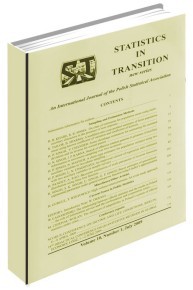ESTIMATION OF INCOME CHARACTERISTICS FOR REGIONS IN POLAND USING SPATIO-TEMPORAL SMALL AREA MODELS
ESTIMATION OF INCOME CHARACTERISTICS FOR REGIONS IN POLAND USING SPATIO-TEMPORAL SMALL AREA MODELS
Author(s): Alina Jędrzejczak, Jan KubackiSubject(s): Business Economy / Management
Published by: Główny Urząd Statystyczny
Keywords: small area estimation; spatio-temporal models; Rao-Yu model; EBLUP estimation
Summary/Abstract: The paper presents the comparison of estimation results for spatial and spatiotemporal small area models. The study was carried out for income-related variables drawn from the Polish Household Budget Survey and explanatory variables from the Polish Local Data Bank for the years 2003-2013. The properties of EBLUPs (Empirical Best Linear Unbiased Predictors) based on spatiotemporal models, which utilize spatial correlation between neighbouring areas as well as historical data, were compared and contrasted with EBLUPs based on spatial models obtained separately for each year and with EBLUPs based on the Rao-Yu model. The computations were performed using sae, sae2 and spdep packages for R-project environment. In the case of sae package, the eblupFH, eblupSFH and the eblupSTFH functions were used for point estimation along with the mseFH, mseSFH and the pbmseSTFH functions for the MSE estimation, whereas the eblupRY function was applied for the purposes of sae2 package. The precision of direct estimators was guaranteed by the adoption of the Balanced Repeated Replication method. The results of the analysis demonstrate that a visible reduction of the estimation error was achieved for the implemented spatiotemporal small-area models, especially when significant spatial and time autocorrelations were observed. These results are even more valuable than those achieved by the means of the Rao-Yu model. In the computations, three author-defined functions were adopted, which not only enabled the author to perform the extract of random effects for spatial, spatiotemporal and Rao-Yu models, but also made it possible to obtain their decomposition with respect to spatial and temporal parts, thus creating a novel solution. The comparison was carried out using choropleth maps for spatial effects and distributions of temporal random effects for the considered years.
Journal: Statistics in Transition. New Series
- Issue Year: 20/2019
- Issue No: 4
- Page Range: 113-134
- Page Count: 22
- Language: English

